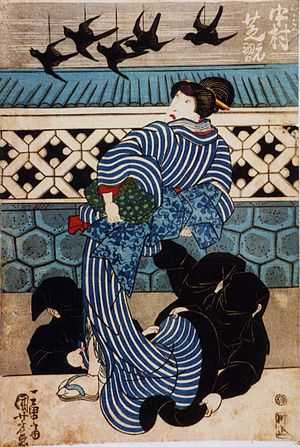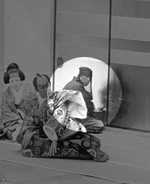Kuroko


Kuroko (黒子 "black person"/"black clothes")[1] are stagehands in traditional Japanese theatre, who dress all in black.
In kabuki, the kuroko serve many of the same purposes as running crew. They move scenery and props on stage, aiding in scene changes and costume changes. They will also often play the role of animals, will-o-the-wisps, or other roles which are played not by an actor in full costume, but by holding a prop. Kuroko wear all black, head to toe, in order to imply that they are invisible and not part of the action onstage.
The convention of wearing black to imply that the wearer is invisible on stage is a central element in bunraku puppet theatre as well. Kuroko will wear white or blue in order to blend in with the background in a scene set, for example, in a snowstorm, or at sea, in which case they are referred to as "Yukigo" (雪子 snow person) or "Namigo" (波子 wave person) respectively. As this convention was extended to kabuki actors depicting stealthy ninja, historian Stephen Turnbull suggested that the stereotypical image of a ninja dressed all in black derived from kabuki.[2] Real ninja, living prior to the advent of kabuki might have dressed in this way occasionally for night work, but certainly wouldn't have worn black at all times.
In Noh theatre, a kōken, wearing black but no mask, serves much the same purpose.
Examples from popular culture
- Kuroko methods were often used by the late Nagi Noda, notably in the Scissor Sisters music video for She's My Man and the MEG video for Precious.[3]
- A Kuroko character appears in some of the Samurai Shodown and Power Instinct video games as the referee, and also a secret playable character occasionally.
- Pretty Polly staged a live Kuroko performance on the 30th October 2007 on a poster site on the M4 London.
- Kuroko were Ryoko Mendou's personal servants in the manga and anime series Urusei Yatsura.
- Kuroko are used extensively in two Super Sentai series, namely "Ninpuu Sentai Hurricaneger" (2002) and "Samurai Sentai Shinkenger" (2009). In the latter's case, when Kamen Rider Decade crossed over with Shinkenger, Tsukasa Kadoya a.k.a. Kamen Rider Decade appears in the Sentai's world as one of the Kuroko of the Shiba household.
- The title character of Kuroko's Basketball has the ability of misdirection, which makes him quasi invisible. This is a reference to the invisibility of the kuroko.
References
- ↑ http://www2.ntj.jac.go.jp/unesco/kabuki/jp/4/4_04_07.html
- ↑ Turnbull, Stephen (2003). "Ninja: AD 1460-1650." Oxford: Osprey Publishing. p14.
- ↑ Precious
- Shōriya Aragorō (2006). www.kabuki21.com. Accessed 29 August 2006.